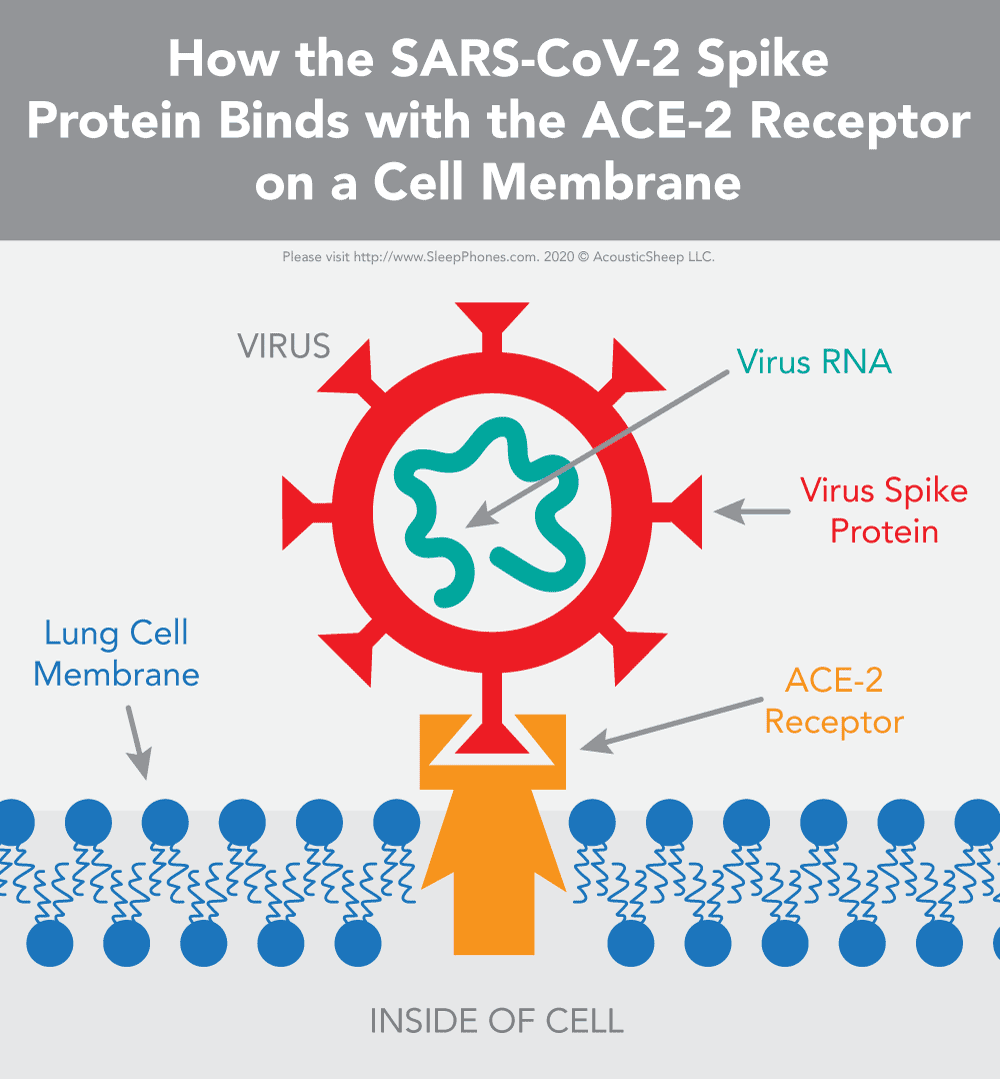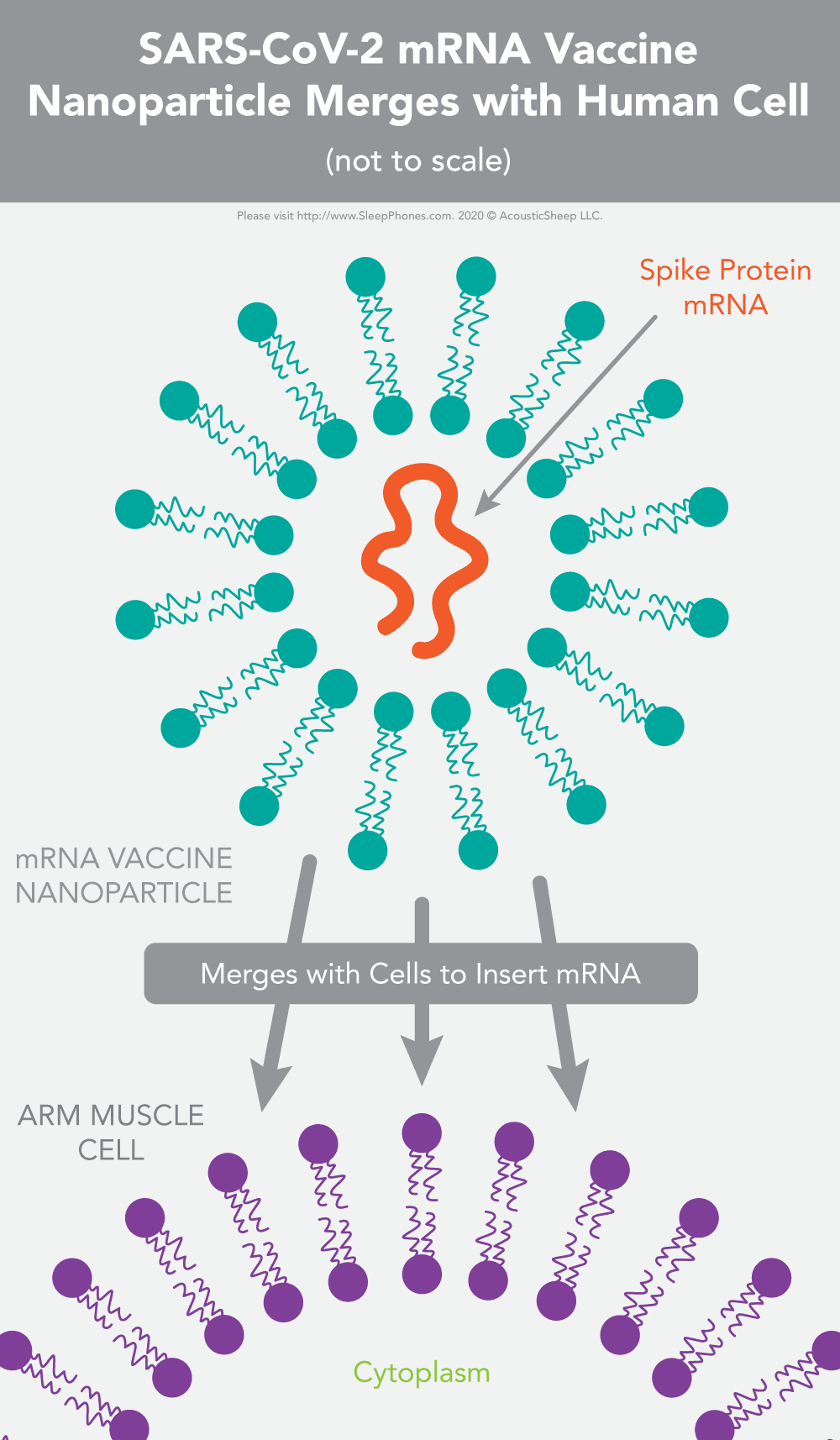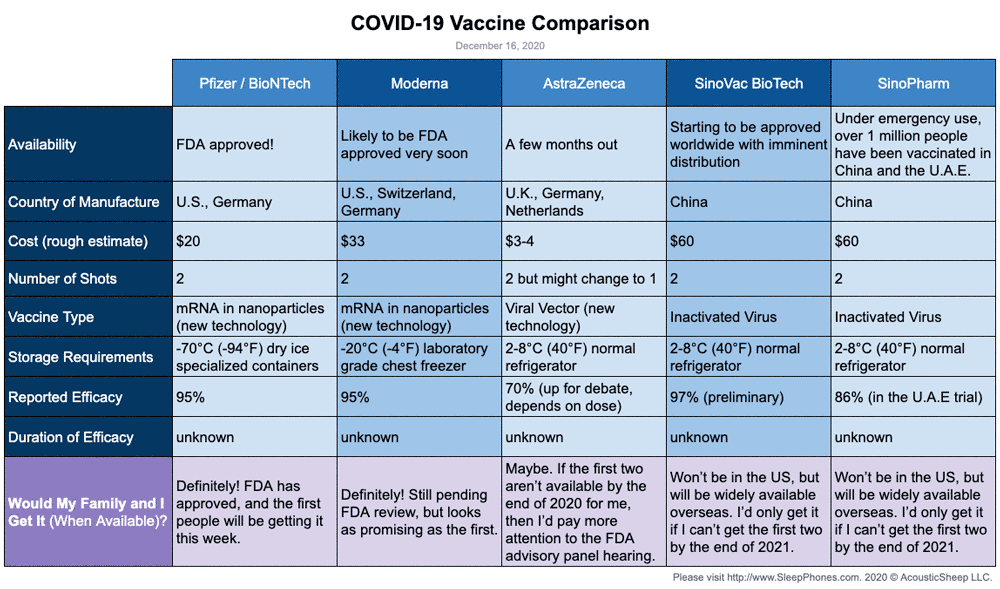15 Questions with Dr. Lai About the Coronavirus Vaccines [Coronavirus Q&A Series]

by Wei-Shin Lai, MD, Co-Founder and CEO of SleepPhones®, background in epidemiology
December 17, 2020
Question 1: Can you explain the latest coronavirus vaccine updates?
Dr. Lai: There are 4 vaccines I’ve been hearing about, which I will go into further detail about in this post.
- Pfizer / Bio-N-Tech mRNA vaccine
- Moderna mRNA vaccine
- Oxford / AstraZeneca viral vector vaccine
- Sinovac and Sinopharm inactivated virus vaccines (very similar)
Question 2: What Is the Pfizer Vaccine?
Dr. Lai: The Pfizer vaccine is the one that needs to be ultra cold, transported and stored in dry ice. It’s the one just approved on Friday, December 11 by the FDA’s Emergency Use Authorization. In the final FDA report, it has 95% efficacy. Over 45,000 people were in the Phase 3 trial (half placebo, half vaccine). Potential adverse reactions experienced by the vaccine recipients were discussed during Thursday’s December 10th’s advisory panel meeting, and no significant issues were found. Of course more people in the vaccine group had a sore arm and that sort of thing, just like with tetanus shots.
Question 3: Should Women Who Are Pregnant Get The Vaccine?
Dr. Lai: It just so happened that 12 women in the vaccine group happened to be pregnant when they received the shots. (They likely did not know they were pregnant when they enrolled in the study or became pregnant between shots.) There have been no problems with those pregnancies. I mention the pregnancy data because there are rumors that the vaccine makes women sterile or that it attacks the placenta in some type of autoimmune reaction. One post even had citations to scientific articles. I looked at a few of those citations, and the research was simply misinterpreted by someone who didn’t understand the subject. Clots formed in the placenta of pregnant COVID patients not because of an autoimmune process but because the virus attacks the blood vessel lining leading to clots. Should we be extra cautious with pregnant women? Of course! But the few things I’ve seen on social media so far were stupid. On December 13, the American College of Obstetricians and Gynecologists (the leading group for OB/GYN in the country) endorsed this vaccine for pregnant and lactating women.
Question 4: What is the Moderna Vaccine?
Dr. Lai: We don’t have detailed information from Moderna yet because they are 1-2 weeks behind Pfizer. They haven’t sat for a publicized hearing in front of an FDA advisory panel yet. Moderna’s vaccine is based on very similar technology to Pfizer’s. Their temperature requirement is much easier to achieve. They can be transported and stored in regular laboratory freezers. Why are the temperature requirements so different when the vaccine technology is similar? Probably because they chose to test it at higher temperatures. Pfizer scientists are now testing their vaccine to see if it is similarly effective when stored at higher temperatures. If a vaccine is tested at a certain temperature, they have to stick with the clinical trial test conditions.
Question 5: What Are The Challenges With Transporting and Storing Dry Ice?
Dr. Lai: Dry ice transport and storage is challenging. When dry ice becomes warmer, it skips the liquid state and becomes carbon dioxide gas (a process called sublimation), which takes up much more space. Once, my kid and I were doing science experiments with dry ice, and I had the idea of exploding a plastic bottle. We put small chunks of dry ice into an empty bottle, poured in a small amount of water, and sealed the lid. We watched the bottle grow in size and moved back. A few seconds later, it exploded. The cap flew up and made a big hole in the kitchen ceiling, and the bottle itself was in multiple pieces scattered 20 feet from its original position. We were just lucky we weren’t hit by the debris. It was stupid. Don’t try it at home. Or wear goggles and protective gear outside. In any case, working with dry ice is not as easy as it may seem.
Question 6: What is an mRNA Vaccine?
Dr. Lai: The Pfizer and Moderna mRNA vaccines are brand new. No widely available vaccine has used this technology. They use nanotechnology and have been developed in research environments for years specifically for brand new infectious diseases like what we are seeing now. It can be made quickly - and believe it or not, this is super quick.
Question 7: Should We Be Concerned That This Vaccine Was Developed So Quickly?
Dr. Lai: Some people worry about the speed of vaccine development because “traditional” vaccines took many years to develop. Vaccines only take a long time because of paperwork and logistics. The amount of human testing is similar to any other vaccine except for the length of followup (which will just have to take more time). I’m not concerned about the speed of development. The various phases of testing seem to be done by the book.
Question 8: Should We Be Concerned About Long Term Issues?
Dr. Lai: The biggest unknown in my mind is long term issues. I actually cannot come up with any scientific pathway by which the vaccine can cause long-term problems - a good thing! But I’ve learned from clinical practice that every body is different, and we react very differently to the same thing. You just can’t predict everything, so you have to carefully follow what happens over time with a wide variety of people. Although there were 45,000 people in the trial, it specifically excluded children, pregnant women, people with a history of bad vaccine reactions, and immunosuppressed people. (They are now recruiting kids ages 12 and up.) We also have to wait and see when boosters will be needed, which is a likely possibility.
Question 9: Is My Doctor Getting the Vaccine?
Dr. Lai: Based on what I know right now, I have no hesitation for getting the vaccine. I am much more likely to have a bad outcome from catching the virus. Most of us will eventually be exposed to this virus when we resume normal lives again. We can do our best to delay exposure to after getting the vaccine. Since over 21,720 people have had the Pfizer vaccine already and no one died or and only one had to be hospitalized (for COVID-19), that’s already better odds. The mortality rate of COVID-19 is approximately 0.3% for my age group (40’s). That’s 3 deaths and 180 hospitalizations in one thousand cases. If all 21,270 people in the trial were my age and got COVID-19, roughly 64 would die and 3,800 would need to be hospitalized. If I was a gambler (and even if I wasn’t), I’d definitely get the shot.
Question 10: Can You Break Down the Biology Of It All?
Dr. Lai: Of course, I’d be happy to get into the biology of the vaccines. You know DNA, right? Deoxyribonucleic acid (DNA) encodes everything with the four letters GACT in the nucleus. To make proteins, our cells use the DNA template to translate that code into mRNA (messenger ribonucleic acid) that goes out of the nucleus into the cytoplasm.
mRNA is also based on four matching letters (GACU) except the letters are all made with ribonucleic acid, which is single-stranded and less stable, breaking down over time in the cytoplasm from various enzymes. Every 3 letters on RNA codes for a particular amino acid. In the process called translation, cellular machinery “read” the code and match it up to amino acids. Then the chain of amino acids fold up and become a protein with a certain shape and function. The vaccine mRNA encodes the spike protein. The coronavirus capsule “spike” protein is the “key” that fits the “lock” ACE protein on the surface of many cells in our body to gain entry and cause havoc.

If we get sick with COVID-19, our bodies would produce antibodies against that “spike” protein to neutralize it so it can no longer enter our cells. Our antibodies sticking to the spike protein would also alert the immune system to get rid of the virus or a cell that is leaking spike protein.
The vaccine basically injects the code for the spike protein into our arm. The cells that follow that mRNA blueprint would make spike protein. Our immune system would recognize the spike protein as foreign and attack it. That’s why you might have some arm soreness.
Question 11: Why Don’t We Just Directly Manufacture the Spike Protein?
Dr. Lai: We don’t have the ability to make complex proteins yet. Proteins are more complex than RNA. The science isn’t available. What’s the difference between RNA and mRNA? mRNA is just a long chain of RNA with specialized beginning and ending sequences that is ready to be translated into proteins.
Question 12: What Are the COVID-19 Vaccine Ingredients?
Dr. Lai: We can make vats of the 4 RNA letters. Scientists can just affix one letter after another until they have the entire long string of letters. As soon as the genetic sequence of the coronavirus was released back in January, we had the ability to make this vaccine, which we started immediately.
Now, naked RNA is not very stable, and it’s not going to just magically get translated into proteins. It has to be in a cell’s cytoplasm to work. With injections, most of the vaccine liquid is going into the space between cells, not into cells. The vaccine still has to be “taken in” by the cells. So scientists developed nanotechnology (very tiny) lipid (fat/oil) micelles (balls) to enclose the mRNA. If you recall from biology class, our cells have a lipid membrane. These lipid nanoparticles merge with our cell membranes and release the mRNA into the cytoplasm where they can be translated into spike proteins. (Envision two blobs of oil merging in a pot of water.) Scientists have only started to work with this type of technology for vaccine development in the past few years.

Side note: Nanotechnology just refers to anything that’s tiny. It has nothing to do with microchips. There is technology in the word because making things tiny requires advanced machines. It’s not a nano Wi-Fi RFID Bluetooth tracking system. It’s just tiny oily bubbles holding long mRNA molecules and a few proteins.
As I mentioned earlier, mRNA isn’t super stable. Plus, cells don’t automatically translate all mRNA into proteins repeatedly until the mRNA disintegrates. We don’t want to waste the vaccine mRNA. We really want the cells that take up the vaccine to translate as many copies of the spike protein as possible so our immune system has plenty of enemy spike proteins to train against. The vaccine manufacturers use proprietary tricks to make the mRNA more appealing and more stable (called adjuvants). We probably won’t get that trade secret even during the FDA hearings. So that’s another unknown in my mind. We don’t know much about the adjuvants in the vaccines. But it wouldn’t be anything elaborate, and it is unlikely to cause problems. The nanoparticle lipids (totally benign fats) seem to be more reactogenic than the adjuvants.
The mRNA vaccine ingredients include the mRNA inside of a fat blob along with some company proprietary adjuvants. We won’t know every last ingredient in the vaccines, but based on what we know about the production, there are no parts of fetuses, mercury, thimerosal, or tracking devices. To summarize, although the Pfizer and Moderna vaccines don’t have any long term safety data, the statistics are really quite favorable. I would definitely get either vaccine, based on what I know at this time.
Question 13: What Is the Oxford / AstraZeneca Vaccine?
Dr. Lai: You may have heard about a botched vaccine trial. That was the Oxford / AstraZeneca vaccine. Apparently a vaccine contractor messed up and only provided half of the normal dose to some volunteers. The statisticians had to figure out how to interpret the data. At this point, they’ve decided to do another Phase 3 trial to instill more confidence. It actually won’t take too long to complete. With the current surge of cases, there will be plenty of volunteers for the vaccine, and the time it takes for a statistically significant number of placebo group volunteers to get sick (almost all of us engage in activities with at least some level of risk) probably won’t take as long as the first phase 3 trial.
The AstraZeneca vaccine is made with a chimpanzee adenovirus. Some adenoviruses cause the common cold. It has two main modifications. The first is that it’s replication deficient. So while you get injected with a virus, the virus can’t make many more copies of itself. The second modification is the insertion of the spike protein gene. Since adenoviruses are DNA viruses, the spike protein gene is in DNA form. When the vaccine is injected, the viruses enter cells through the usual adenovirus mechanisms. The virus takes over the cell’s machinery to make what’s encoded by the virus’s DNA, which now includes the SARS-CoV-2 spike protein. Our immune system learns to recognize the spike protein. This method of vaccine production has been studied for over 30 years and finally deployed widely here. It’s been developed for Ebola and HIV, but there have been some concerns. That’s why I’m a bit hesitant with this vaccine. With this one, I can envision theoretical biological pathways leading to unexpected problems. But that’s just theory, and it’s been quite safe during the trials so far. I would get it if the mRNA vaccines weren’t available quickly to me. The U.S. government ordered 300 million doses of this vaccine, which would cover almost half of the population in the U.S. if it remains 2 shots a person. I do want to point out that this is the cheapest option available. Once it’s proven safe, this may be the most widely distributed vaccine in terms of number of people, particularly in less-rich countries.

Much of the Eastern world, Middle East, Africa, and South America currently have contracts with China for their inactivated virus vaccines. This is old technology. They have to grow the virus in labs then inactivate the virus. Therefore, it’s more expensive than the previously mentioned vaccines. Viruses can only grow in live cells, so you have to culture lots of live cells to get enough virus. It’s a tried and true technique already used for polio and flu, so it should be quite safe. It was developed quickly and many million doses have already been used in trials and emergency use in China. Because there is more of this vaccine at this time, it’s important to mention here, though we are unlikely to have access in the U.S. The Russian Sputnik V vaccine uses an adenovirus vector, similar to the AstraZeneca vaccine. We are unlikely to use it in the U.S.
Question 14: Could I Get COVID-19 from the Vaccine?
Dr. Lai: With the mRNA vaccines (Pfizer, Moderna) and the adenovirus vaccines (AstraZeneca, Sputnik V), it would be literally impossible to get COVID-19, since no virus was ever used in the manufacturing. Only the spike protein’s genetic code is incorporated in the vaccine, not the entire virus’s genetic code. With the SinoTech and SinoPharm vaccines from China, if the inactivation process was really badly botched, then it would theoretically be possible to have live viruses left in the vaccine. There are several controls in the manufacturing that make that very very unlikely. The flu vaccine is an inactivated virus vaccine, and we haven’t heard of the flu vaccine being botched to this degree in the past few decades.
Question 15: If I Have the Coronavirus Antibodies, Do I Need to Get the Vaccine?
Dr. Lai: The amount of antibodies a person who had a natural infection goes down after 90 days. When the amount of vaccines is scarce like it is right now, it would be nice for someone who is less than 90 days out from infection to defer the vaccine. But when there is enough vaccine to go around for everyone, it would be useful to get the vaccine even if you’ve been infected before. Based on the research, the vaccine actually helps your body generate longer lasting antibodies than most natural infections. The current estimates for the mRNA vaccines is for at least 6-12 months of protection compared with 3 months with a natural infection.
If you are curious about anything else, please contact us through customer service! I’m happy to help you understand the science so you can draw your own conclusions.
